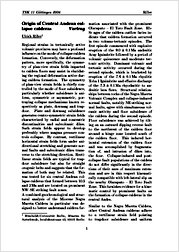Origin of Central Andean collapse calderas
2006Universitätsverlag Göttingen
Sammelband- / Konferenzbeitrag
Verlagsversion
Deutsch
Riller, Ulrich, 2006: Origin of Central Andean collapse calderas. In: Philipp, S.; Leiss, B; Vollbrecht, A.; Tanner, D.; Gudmundsson, A. (eds.): 11. Symposium "Tektonik, Struktur- und Kristallingeologie"; 2006, Univ.-Verl. Göttingen, p. 180 - 181., , DOI: 10.23689/fidgeo-1879.
 |
Dokument öffnen: |
Regional strains in tectonically active
volcanic provinces may have a profound
influence on the mode of collapse caldera
formation. Conversely, the deformation
pattern, more specifically, the symmetry
of plan-view strain fields imparted
to caldera floors may assist in elucidating the regional deformation active during
caldera formation. The symmetry
of plan-view strain fields is chiefly controlled
by the mode of floor subsidence,
particularly whether subsidence is uniform,
symmetric or asymmetric, portraying
collapse mechanisms known respectively
as plate, downsag and trapdoor.
Plate and downsag subsidence
generates centro-symmetric strain fields
characterized by radial and concentric
discontinuities and subvolcanic dikes.
Such strain fields appear to develop
preferably where magma pressure controls
collapse. By contrast, rectilinear
horizontal strain fields form under unidirectional
stretching and generate normal
faults and subvolcanic dikes transverse
to the stretching direction. Rectilinear
strain fields are typical for trapdoor
subsidence but also for straight
orogenic belts and suggests that the formation
of both may be related. This
was tested for six central Andean collapse
calderas that formed between 10.5
and 2Ma and are located on prominent
NW–SE striking fault zones.
A combined geochronological and structural
analysis of the Miocene Negra
Muerta Caldera in particular was designed
to better understand caldera formation
associated with the prominent
Olacapato – El Toro Fault Zone...

